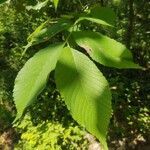Trees , 18-35 m; crowns open. Bark brown to red, deeply and irregularly furrowed. Wood soft. Branches spreading; twigs gray, densely pubescent when young, glabrous with age. Buds obtuse; scales red, margins red-tomentose. Leaves: petiole 5-7 mm, pubescent. Leaf blade obovate to ovate, 8-16 × 5-7.5 cm, base oblique, margins doubly serrate in distal 1/2-3/4, singly serrate proximally, basal teeth 6 or fewer, rounded, less distinct, apex acuminate; surfaces abaxially tomentose, dense tufts of white hair in axils of major veins, adaxially harshly scabrous, trichomes pointed toward apex, margins ciliate. Inflorescences dense fascicles less than 2.5 cm, 8-20-flowered, flowers and fruits not pendulous, subsessile; pedicel 1-2 mm. Flowers: calyx green to reddish, shallowly lobed, lobes 5-9, reddish pubescent; stamens 5-9; anthers reddish; stigmas exserted, pink reddish. Samaras yellow to cream, suborbiculate, 12-18 mm diam., broadly winged, samaras pubescent on body only, rusty-tomentose, margins glabrous. Seeds thickened, not inflated. 2 n = 28.
More
A medium sized tree. It grows to 25 m tall. The trunk is 60 cm across. The bark is dark brown and deeply furrowed. The inner bark is slimy. The crown is open and flat topped. The branches are spreading. The leaves are large and rough. They are in 2 rows and 10-18 cm long and 5-7.5 cm wide. They are narrowly oval with an abrupt long point. The base is rounded and the sides are very unequal. There are double teeth along the edge. There are straight parallel veins along each side. The leaves are thick. They are dark green and rough above and have soft hairs underneath. They turn dull yellow in autumn. The flowers are 3 mm wide and green. There are many flowers on short stalks along the twigs. The fruit are 12-19 mm long. They are 1 seeded keys. They have light green broad and hairless wings.
Tree to 20 m, with the shape of no. 1 [Ulmus americana L.], the twigs scabrous-pubescent; winter-buds densely covered with red-brown hairs; lvs oblong to obovate, thick and stiff, usually 10–20 cm, very rough above; fls fascicled, subsessile; stamens 5–9; stigmas pink; fr suborbicular, 1.5–2 cm, pubescent over the seed, otherwise glabrous, scarcely reticulate; 2n=28. Moist woods; s. Me. and s. Que. to e. N.D., s. to Fla. and Tex. (U. fulva)
Rich deep soils, often calcareous, on the banks of streams and low rocky hillsides. Lower slopes, alluvial flood plains, stream banks, riverbanks, and wooded bottom lands; at elevations up to 600 metres, occasionally to 900 metres.
More
It is a temperate plant. It grows best on rich soils along streams. In the USA it grows up to 600 m altitude. It suits hardiness zones 3-9.




